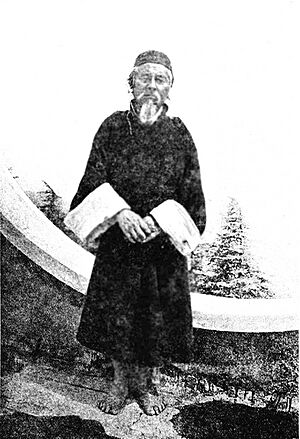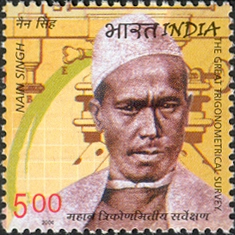Pundit (explorer) facts for kids
The word pundit or pandit was used in the late 1800s for special explorers. These were local people from India who helped the British map out areas north of British India.
Some famous local explorers included the cousins Nain Singh Rawat and Krishna Singh Rawat.
Mapping India and Beyond
One of the biggest mapping projects in the 1800s was the Great Trigonometric Survey of India. The British wanted to map not just India, but also the lands further north. This wasn't just for science. Russia was trying to expand its empire into Central Asia. The British worried Russia might try to take over India, which was a British colony at the time. So, both countries tried to gain influence in Asia. Knowing the geography of these areas was super important in this competition, often called 'The Great Game'.
However, mapping some areas was very hard. Countries like Tibet, which bordered India, did not allow Westerners to enter. A British mapping team would definitely not be allowed in. In the 1860s, Captain Thomas G. Montgomerie, who worked on the survey, had a clever idea. He realized they could train local people from places like Sikkim to be surveyors. These local explorers would not look suspicious like Europeans. They could pretend to be traders or lamas (holy men) while making their observations. These native surveyors were called pundits. One pundit, Kinthup, made an amazing discovery. He was the first to find out that the Tsangpo River was actually part of the Brahmaputra. Before him, no one knew if it flowed to the Pacific or Indian Oceans!
How Pundits Explored Secretly
The pundits learned many clever tricks to make their maps without being caught. They were taught to walk very carefully, taking "exactly two thousand steps to a mile." To count their steps, they used something that looked like a Buddhist rosary, called a mala. But instead of the usual 108 beads, it had 100. Every tenth bead was a bit bigger. They would drop one bead for every 100 steps they took.
They also used a prayer wheel that looked normal. But instead of the usual Buddhist prayer Om mani padme hum, the scroll inside was blank. This blank paper was used to secretly write down their map data. Pundit Nain Singh Rawat even found a way to use the prayer wheel to keep curious people away. If someone came too close, he would start spinning the wheel. This made it look like he was deep in religious thought, and usually, people would leave him alone. Another way they kept their observations secret was by turning them into poems. They would then recite these poems during their travels.
The pundits received lots of training in surveying. They learned to use a sextant (a tool for measuring angles). They also learned to figure out how high a place was by measuring the temperature of boiling water. They even learned how to make observations of the stars. Plus, they got medical training. Even with all these tricks and precautions, some pundits were sent back, tortured, or even killed. But thanks to their brave journeys, they managed to map the Himalaya mountains, Tibet, and nearby areas with amazing accuracy.
Famous Pundits
- Hari Ram
- Kinthup
- Krishna Singh Rawat
- Mani Singh Rawat
- Nain Singh Rawat
Pundits in Stories
The training of a pundit is described in Rudyard Kipling's famous novel Kim.



